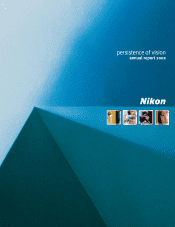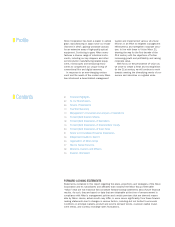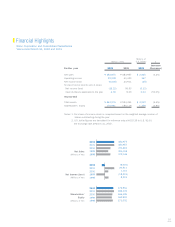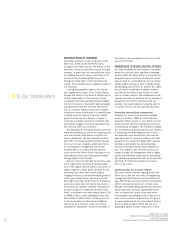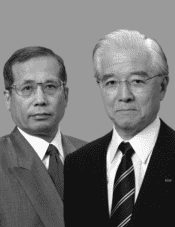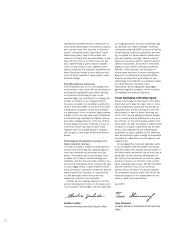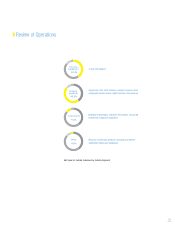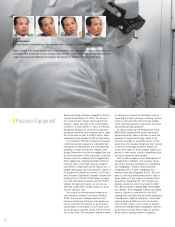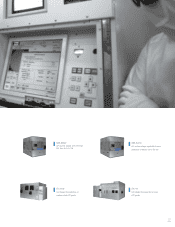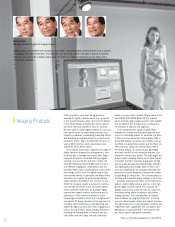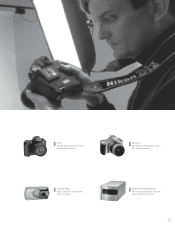Nikon 2002 Annual Report Download - page 10
Download and view the complete annual report
Please find page 10 of the 2002 Nikon annual report below. You can navigate through the pages in the report by either clicking on the pages listed below, or by using the keyword search tool below to find specific information within the annual report.
08
Imaging Products
Initial projections were that strong growth in
demand for digital cameras would prop up growth
in the overall camera market. The terrorist attacks
in the United States in September 2001 caused
the North American market to cool off, however.
We were able to avoid negative effects on our busi-
ness performance by undertaking thorough cost-
reduction measures, accelerating marketing efforts
and achieving a rapid adjustment in inventory and
production levels. Sales increased 23.0% year on
year to ¥221.6 billion, while operating income
soared 53.6% to ¥16.1 billion.
The company continued to augment the range of
digital cameras designed for photographers, from
professionals to average consumers alike. Major
new product launches included SLR-type digital
cameras such as the D1x and D1Hmodels, the
COOLPIX 5000 and COOLPIX 885 (with 5.0 and
3.2 effective megapixels, respectively), and the
COOLPIX 2500, which incorporates an inner-swivel
lens design. Profits from the digital camera seg-
ment proved healthy. In particular, the Nikon brand
dominates the market for professional SLR-type
digital cameras. Building on this position, in June
2002 the company sought to expand its success
into the high end of the mass consumer market
when it launched the D100, an SLR-type digital
camera that targets amateur enthusiasts and is
planning to further develop businesses in the
increasingly-competitive low-end of the digital cam-
era market. To supply demand in this segment, the
company newly established a manufacturing sub-
sidiary for digital cameras and other imaging prod-
ucts in the city of Wuxi, China (Jiangsu Province).*
Including the existing plant in Thailand, this pro-
vides Nikon with two major offshore production
bases to supply major markets. Strong sales of the
new SUPER COOLSCAN 8000 ED film scanner,
which combines high image resolution with capabili-
ties for different film formats, also contributed to
the increase in sales in this segment.
In the traditional film camera market, Nikon
expanded its market share by launching new prod-
ucts into a shrinking market. In particular, the Nikon
U (F65 overseas, except the United States/N65 in
the United States), as well as new models such as
the FM3A,a manual focus model, and the Nikon Us
(F55 overseas, except the United States/N55 in
the United States), an ultra-compact, lightweight
automatic model but with advanced features, con-
tributed to overall sales growth. This was largely the
result of past marketing efforts, which have helped
to position the Nikon brand as a guarantor of high
picture quality and advanced functionality. Besides
this high-quality brand image, sales of Nikon cam-
eras also benefited as the company launched new
easy-to-use models designed to expand the market
by appealing to young users. The company plans to
continue this successful brand strategy in the future.
Business development efforts are focused princi-
pally on related digital camera services in the high
growth digital camera market. The company has
already commenced online services for customers,
including printing, album production and picture-
sharing services. The company plans to expand
such initiatives by using the Internet to introduce
users to camera-repair outlets and related services.
Through investment in local production facilities and
heightened sales capabilities, the company is also
gearing up to supply demand in the Chinese mar-
ket, which harbors high growth potential.
Michio Kariya
Managing Director, President of Imaging Company
Always putting user operability and convenience first, Nikon is developing digital cameras that are easy to operate
for traditional film camera users also. The company is also launching radically new types of camera to meet the
needs of a new generation of digital camera users. The swift rise of digital photography provides Nikon with a
fresh growth opportunity.
*Plan to commence operations in April 2003.

